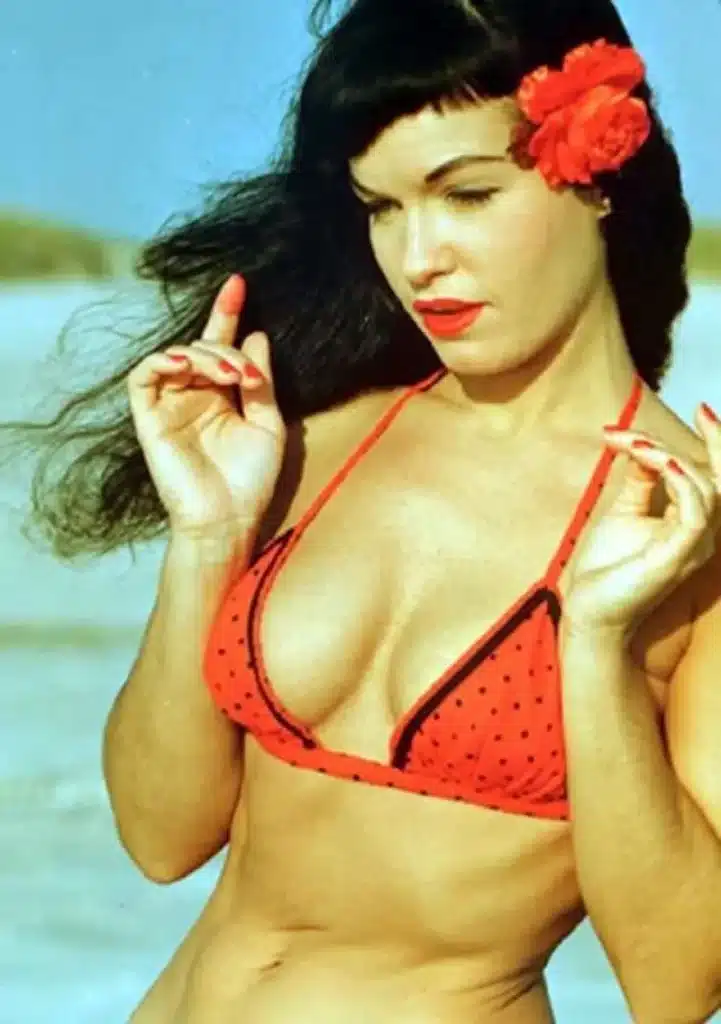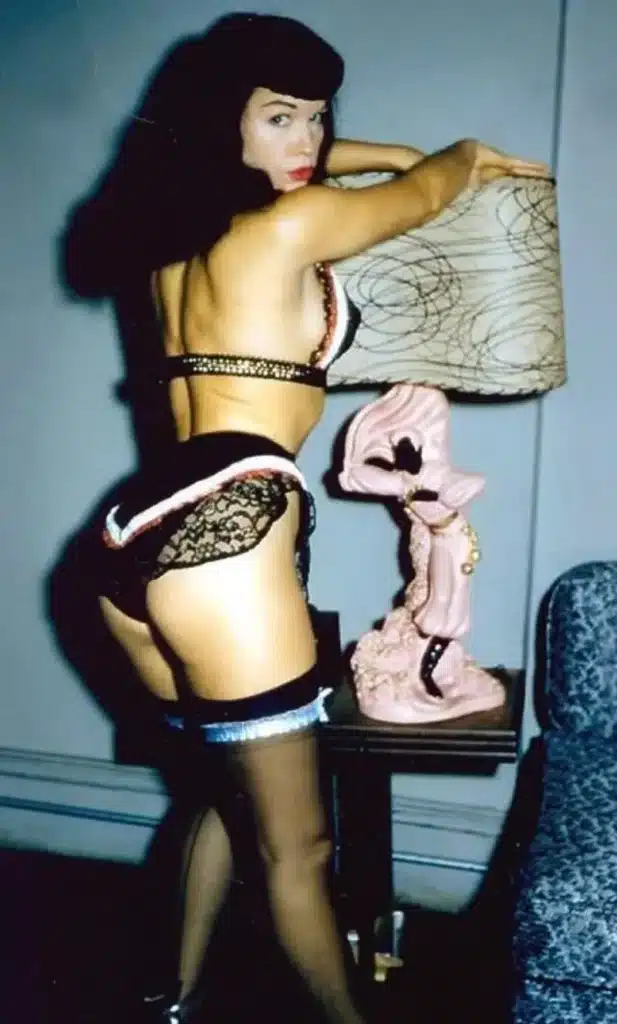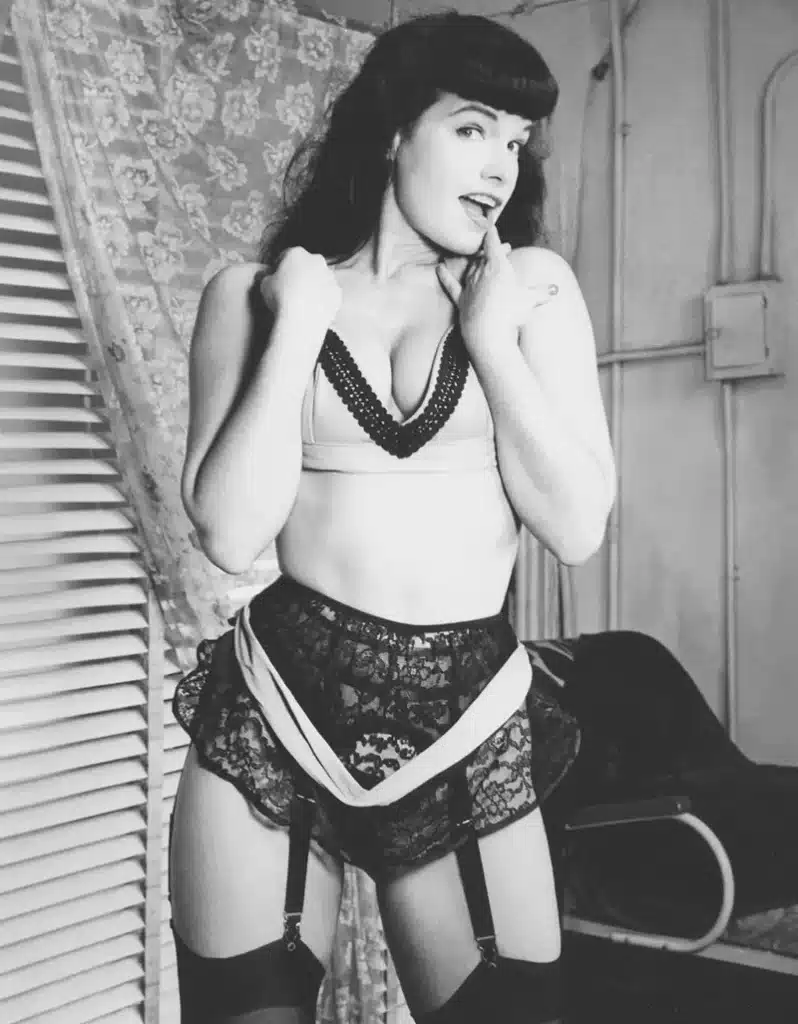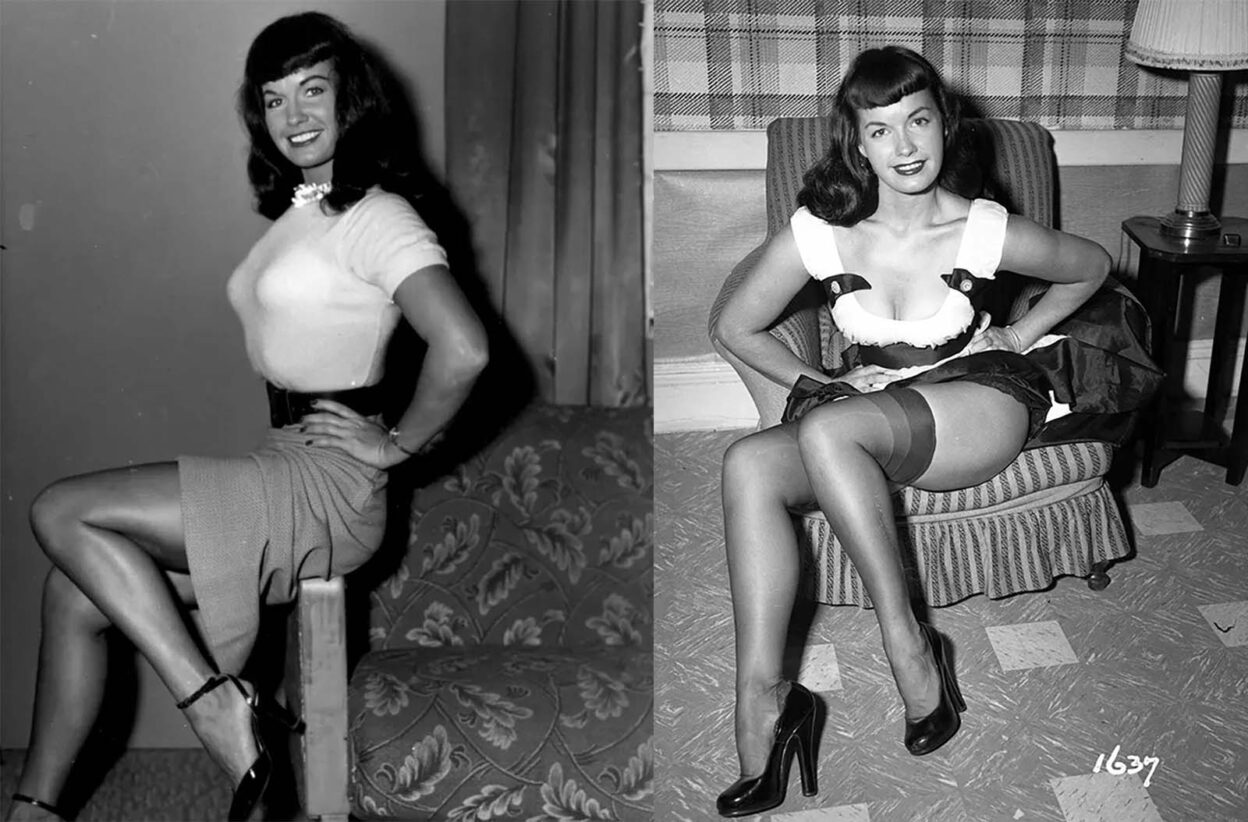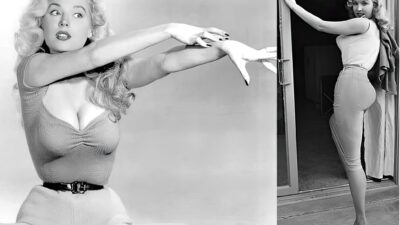Bettie Page, born in 1923, was an American model who rose to fame in the 1950s for her iconic pin-up photography.
Dubbed the “Queen of Pinups,” she became a cultural sensation thanks to her playful confidence, striking blue eyes, signature jet-black hair with short bangs, and curvy figure. Her bold and carefree style not only made her a standout in her time but continues to inspire artists and fashion to this day.
Following her passing, Playboy founder Hugh Hefner praised her as “a remarkable lady, an iconic figure in pop culture who influenced sexuality, fashion, and had a lasting impact on our society.”
Originally from Nashville, Tennessee, Page spent her early adult years in California before relocating to New York City to pursue acting. There, she found steady work as a pin-up model, posing for countless photographers throughout the 1950s.
She became one of Playboy Magazine’s earliest Playmates of the Month, featured as “Miss January 1955.” Though she faded from the spotlight in the years that followed, Page saw a major revival of interest in her work during the 1980s.
In 1959, she had a dramatic shift in her life, converting to evangelical Christianity. She worked briefly with Billy Graham’s ministry and attended Bible colleges in Los Angeles and Portland, Oregon, with aspirations of becoming a missionary.
However, the later years of her life were troubled by mental health struggles, including severe depression, erratic behavior, and a diagnosis of paranoid schizophrenia, which led to several years in a psychiatric hospital.

In late 1947, Bettie Page moved to New York City with dreams of becoming an actress. However, shortly after her arrival, she endured a traumatic sexual assault by a group of men, prompting her to return to her hometown of Nashville. There, she briefly worked for a local railroad service before deciding to give New York another try.
Upon her return, she found work as a secretary for a real estate developer and an insurance broker who shared office space in the Eastern Airlines Building at Rockefeller Plaza.
Page’s life took a turn in 1950 during a walk along the shore of Coney Island. There, she encountered NYPD officer Jerry Tibbs, an amateur photographer with a passion for pin-up photography. Seeing potential in her look, Tibbs offered to help her create her first modeling portfolio—for free.
As part of his guidance, Tibbs suggested she cut bangs to reduce light glare from her high forehead during photoshoots. That simple style tip became a defining feature of her signature look, helping launch her into pin-up stardom.

In late 1947, Bettie Page moved to New York City with dreams of becoming an actress. However, shortly after her arrival, she endured a traumatic sexual assault by a group of men, prompting her to return to her hometown of Nashville. There, she briefly worked for a local railroad service before deciding to give New York another try.
Upon her return, she found work as a secretary for a real estate developer and an insurance broker who shared office space in the Eastern Airlines Building at Rockefeller Plaza.
Page’s life took a turn in 1950 during a walk along the shore of Coney Island. There, she encountered NYPD officer Jerry Tibbs, an amateur photographer with a passion for pin-up photography. Seeing potential in her look, Tibbs offered to help her create her first modeling portfolio—for free.
As part of his guidance, Tibbs suggested she cut bangs to reduce light glare from her high forehead during photoshoots. That simple style tip became a defining feature of her signature look, helping launch her into pin-up stardom.

From late 1951 or early 1952 through 1957, she posed for photographer Irving Klaw for mail-order photographs with pin-up and BDSM themes, making her the first famous bondage model.
Klaw also used Page in dozens of short, black-and-white 8mm and 16mm “specialty” films, which catered to specific requests from his clientele.
These silent one-reel featurettes showed women clad in lingerie and high heels, acting out fetishistic scenarios of abduction, domination, and slave-training; bondage, spanking, and elaborate leather costumes and restraints were included periodically. Page alternated between playing a stern dominatrix, and a helpless victim bound hand and foot.
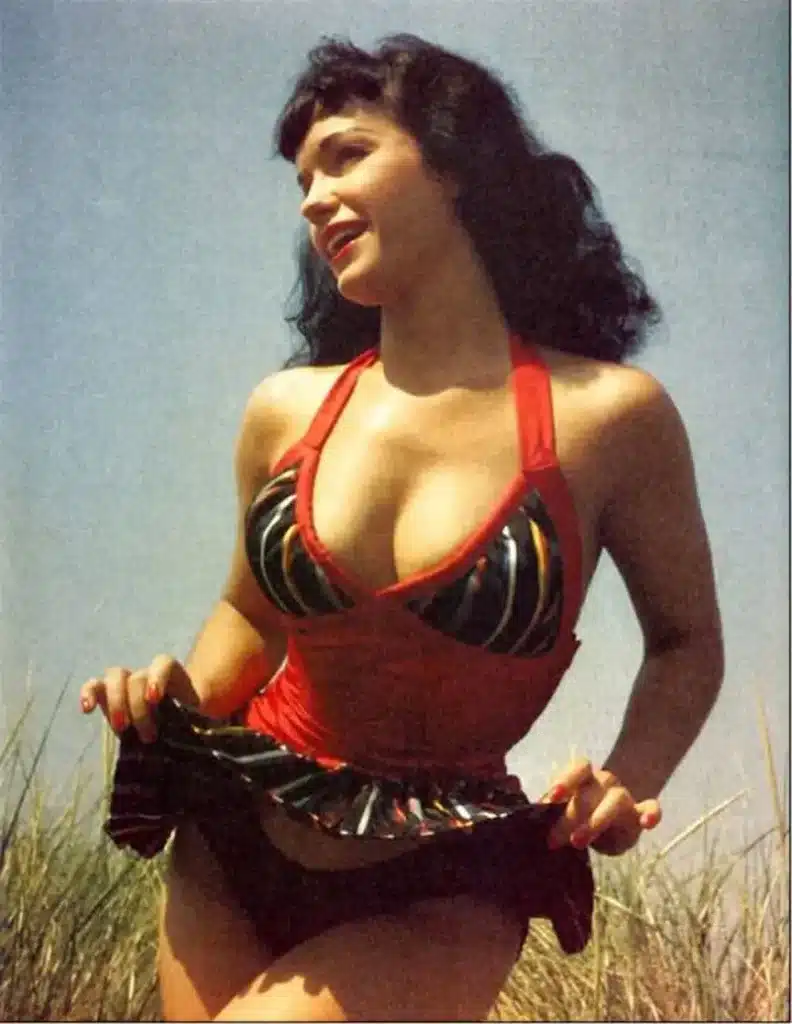
In 1954, during one of her annual trips to Miami, Florida, Bettie Page crossed paths with photographers Jan Caldwell, H.W. Hannau, and Bunny Yeager.
At the time, Page was already the most in-demand pin-up model in New York. Yeager, a former model turned aspiring photographer, arranged a photo session with Page at the now-defunct Africa USA wildlife park in Boca Raton, Florida. The resulting “Jungle Bettie” series from that shoot would become some of the most iconic images of her career.
The photos featured Page posing nude alongside two cheetahs named Mojah and Mbili, capturing a bold, exotic aesthetic. Page designed and handmade the leopard-print jungle outfit she wore for the shoot, just as she often crafted much of her own lingerie—adding a personal, creative flair to her already distinctive style.
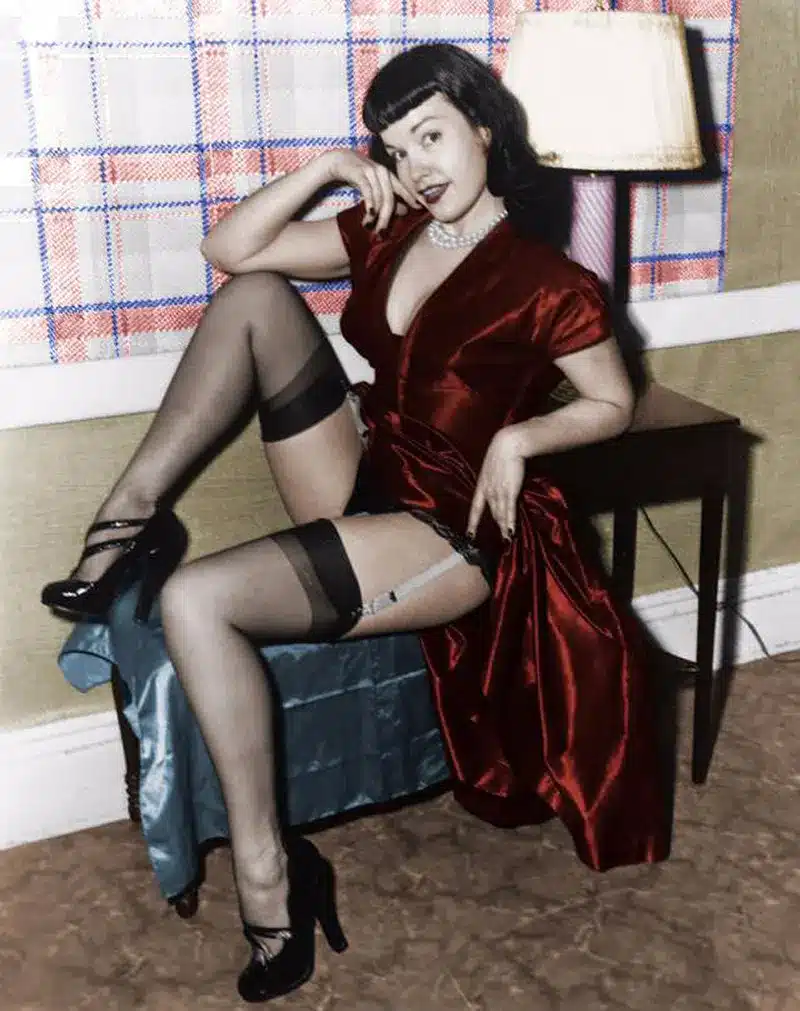
After Bunny Yeager submitted photos of Bettie Page to Playboy founder Hugh Hefner, he selected one for the January 1955 issue, making Page the magazine’s Playmate of the Month. The now-iconic centerfold features Page wearing nothing but a Santa hat, kneeling in front of a Christmas tree, playfully holding an ornament and winking at the camera—a classic blend of charm and sensuality.
That same year, Page was crowned “Miss Pinup Girl of the World”, adding to her growing legend. She also earned nicknames like “The Queen of Curves” and “The Dark Angel”, reflecting both her voluptuous figure and her mysterious, captivating aura.
While most pin-up and glamour models enjoyed brief moments in the spotlight, Page defied the norm. Her popularity endured for years, and she remained one of the most sought-after models until her retirement from modeling in 1957.
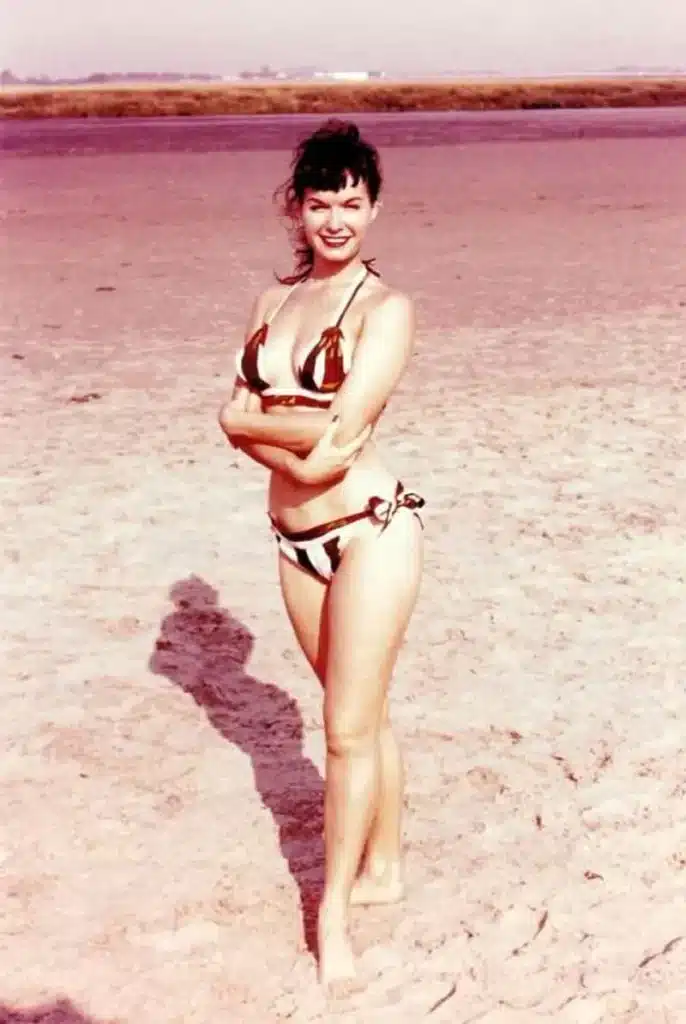
The exact reasons behind Bettie Page’s sudden departure from modeling in 1957 remain unclear, though several theories have circulated over the years. One widely speculated factor involves the Kefauver Hearings, part of the United States Senate Special Committee to Investigate Crime in Interstate Commerce. Reports suggested that a young man had died during a bondage session allegedly inspired by fetish images featuring Page, drawing unwanted attention and controversy to the genre.
Following her exit from the spotlight, Page underwent a profound personal transformation. While living in Key West, Florida, she experienced a religious awakening and became a born-again Christian on December 31, 1959.
Reflecting on her past in a 1998 interview, she admitted, “When I gave my life to the Lord, I began to think He disapproved of all those nude pictures of me.”

During the 1960s, Bettie Page sought to dedicate her life to faith, attempting to become a Christian missionary in Africa. However, her application was rejected due to her prior divorce—an obstacle that deeply disappointed her.
Undeterred, she spent the following years working with various Christian organizations. In 1963, she returned to her hometown of Nashville, Tennessee, where she enrolled at Peabody College with the goal of earning a master’s degree in education. Despite her initial ambition, she eventually withdrew from the program before completing her studies.

In October 1978, Bettie Page relocated to Southern California, but her time there was soon marked by serious mental health struggles. She suffered a nervous breakdown and became involved in a physical altercation with her landlady.
Following psychiatric evaluation, doctors diagnosed her with acute schizophrenia, and she was committed to Patton State Hospital in San Bernardino, where she remained for 20 months.
Later, after another violent incident involving a different landlord, Page was arrested for assault. However, she was found not guilty by reason of insanity and placed under state supervision for eight years. She was officially released in 1992.

According to her long-time friend and business agent, Mark Roesler, Bettie Page was hospitalized in critical condition on December 6, 2008. Conflicting reports emerged about her condition—Roesler told the Associated Press that she had suffered a heart attack, while Los Angeles TV station KNBC reported that she was battling pneumonia.
After several days with no improvement, her family made the difficult decision to discontinue life support. Bettie Page passed away on December 11, 2008, at the age of 85.
